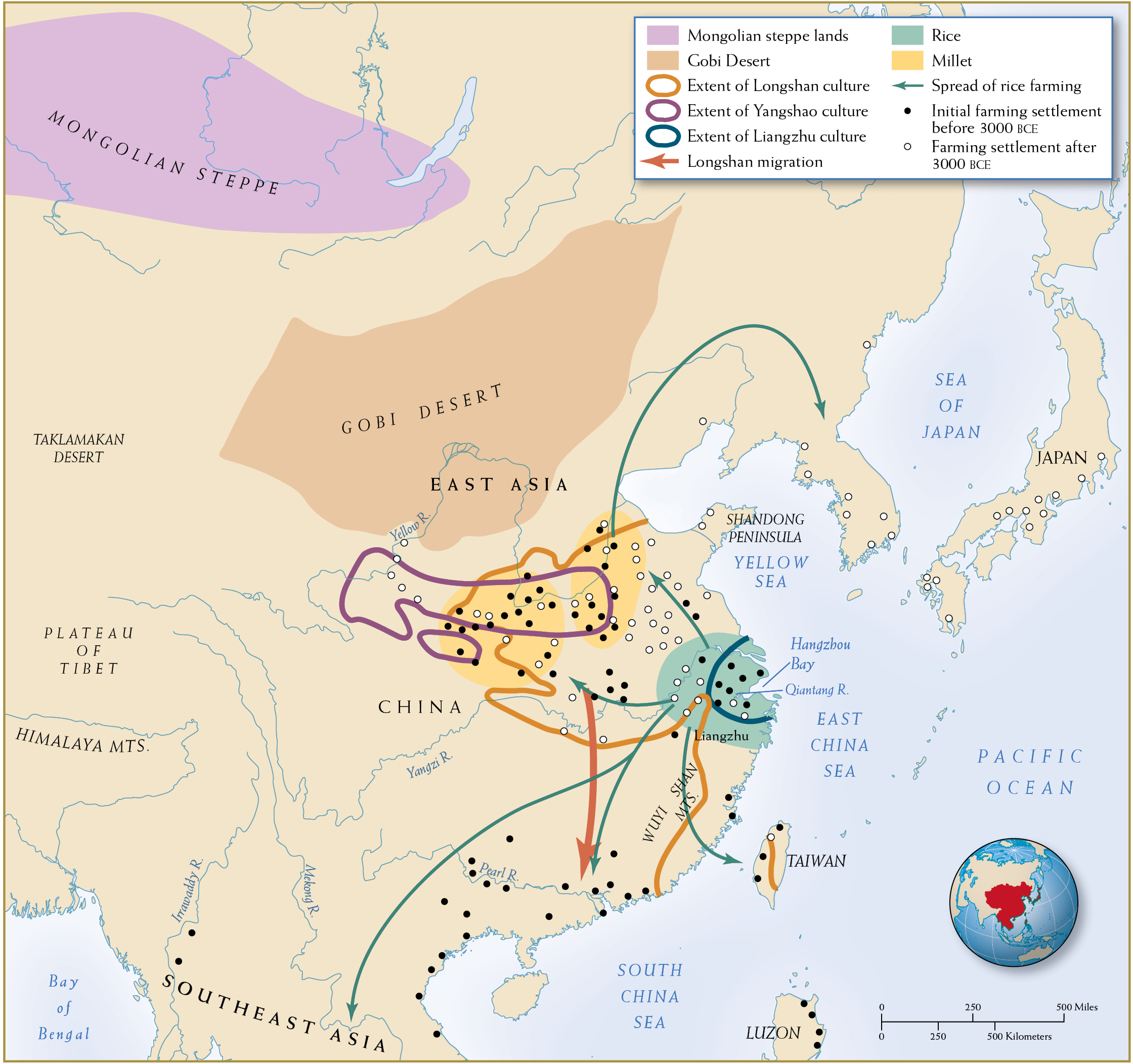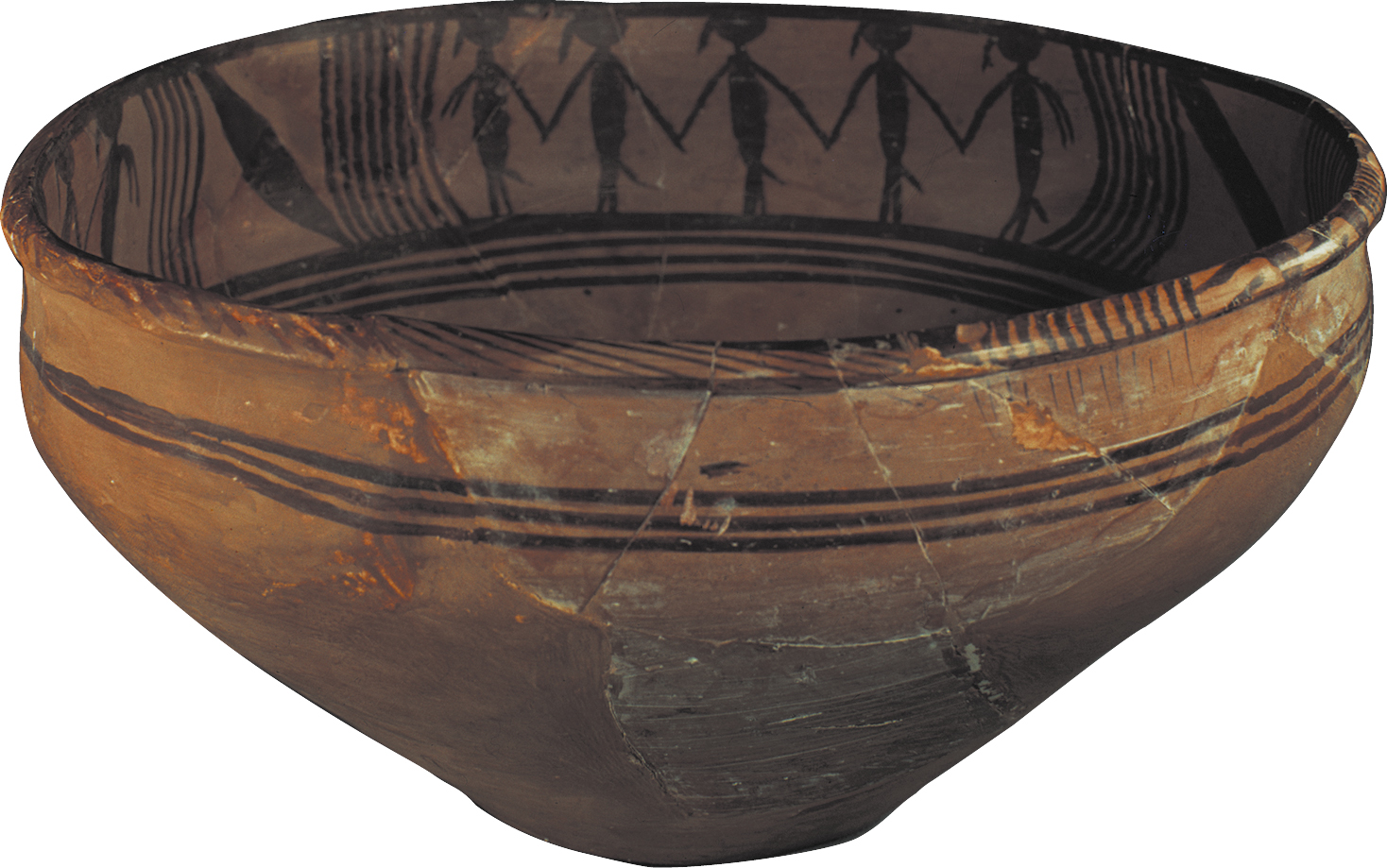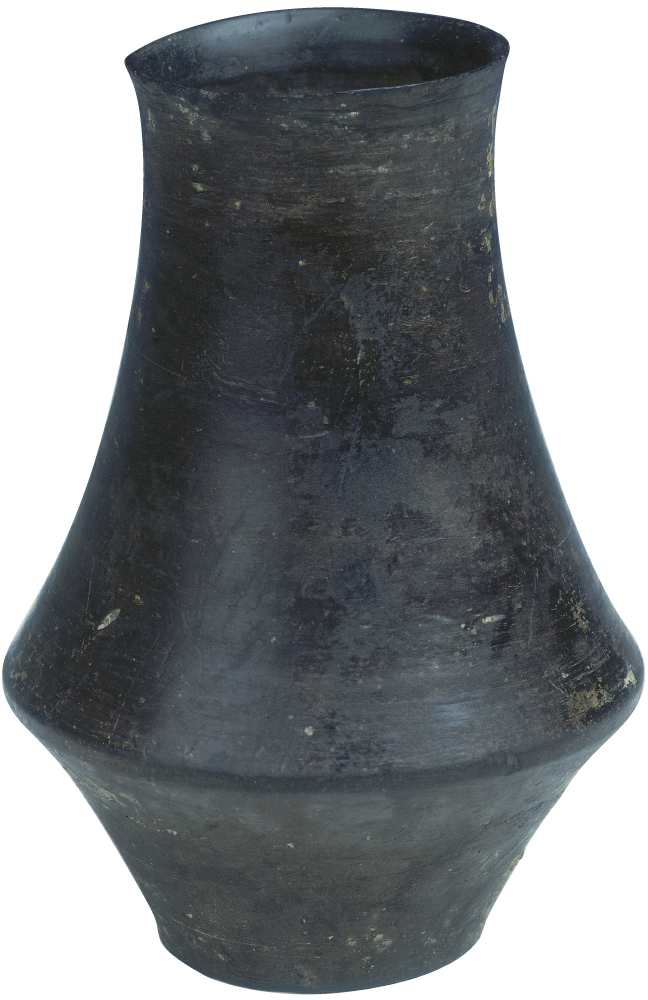THE YELLOW AND YANGZI RIVER BASINS: EAST ASIA
Like the Mesopotamians, Egyptians, and Harappans, East Asian peoples clustered in river basins. Their settlements along the Yellow River in the north and the Yangzi River in the south became the foundation of the future Chinese state. By 5000 BCE, both millet in the north and rice in the south were under widespread cultivation.
Yet in the following three millennia (when Mesopotamia, Egypt, and the Indus Valley were developing complex, city-based cultures), the Chinese moved slowly toward urbanization. China’s great river-basin cultures did not arise until the second millennium BCE. (See Map 2.6.) Like the other regions’ waterways, the Yellow and Yangzi Rivers had annual floods and extensive floodplains suitable for producing high agricultural yields and supporting dense populations. In China, however, the evolution of hydraulic works, big cities, priestly and bureaucratic classes, and a new writing system took longer.

MAP 2.6 | River-Basin Peoples in East Asia, 5000–2000 BCE
Complex agricultural societies emerged in East Asia during the third millennium BCE.
- Locate the three distinct cultures on the map. Where is each located, and what major crop was grown in each?
- What topographical features may have shaped the extent and spread of the various cultures represented on the map?
- Locate the dots for farming before 3000 BCE and those for farming after 3000 BCE. What hypotheses might you offer based on the location of farming before and after 3000 BCE?
Living conditions and the environment played a key role in ancient Chinese society, just as they did in the river-basin cultures of Mesopotamia, Egypt, and Harappa. In the river basins of China, abundant food and widely dispersed communities encouraged the development of localized agrarian cultures. Complex cities would come later. Also contributing to their different development were a lack of easily domesticated animals and plants and an abundance of geographical barriers. Geography isolated China, for the Himalaya Mountains and the Taklamakan and Gobi Deserts prevented large-scale migrations between East Asia and central Asia and hindered the diffusion of cultural breakthroughs occurring elsewhere in Afro-Eurasia.
From Yangshao to Longshan Culture
China’s classical histories have claimed that China’s cultural traditions originated in the Central Plains of the Yellow River basin and spread outward to less developed regions inside and even beyond mainland China. This location, seen by many as the birthplace of China’s imperial traditions, was thought to have exercised a civilizing influence on these other communities. These histories place the beginnings of Chinese culture at the Xia dynasty, dating from 2200 BCE. Archaeological studies of river-basin environments in East Asia tell a different story, however. Whether or not the Xia existed as a historical dynasty, archaeological evidence suggests that our study of the Yellow River basin and Yangzi delta should begin earlier—in the two millennia from 4000 to 2000 BCE.
China in 4000 BCE was very different—in terms of climate, geography, culture, and connectedness—from what it is today. A warmer and moister climate divided its vast landmass into quite distinctive and separate regions. The Shandong Peninsula was an island separated from mainland China. Lakes abounded in southern Manchuria and southern Mongolia, and the Central Plains was a smaller area than it is today. Only after a long cycle of cooler and drier weather did these bodies of water dry up and the landmass become a single geographical unit. According to recent archaeological research, at least eight distinct regional cultures appeared between 4000 and 2000 BCE, and only as these communities interacted did their institutions and ways of life come together to create a unified Chinese culture.
Yet China was a land apart in the Afro-Eurasian landmass, isolated by the mountains of the Tibetan plateau in the west, the deserts of Inner Mongolia in the north, the tropical rain forests in the south, and the ocean in the east. China had only two difficult natural routes to the rest of Asia and Europe. One route led into central Asia by the narrow Gansu Corridor, running between the Qilian Mountains on the northern edge of the Tibetan plateau and the Gobi Desert. The other ran along a narrow band of the steppe north of the Yellow River and around the Gobi Desert, eventually ending up in the Mongolian steppe, the Altai Mountains, and the Kazakh steppe. Though trade with and migration into China were more limited than that which fused together Egypt, Mesopotamia, and the Indus Valley, nomadic cultures and technologies nevertheless filtered from the steppes to settled communities on the rivers.
TWO RIVER BASINS, TWO CULTURES The major divide in China was between the Yellow and Yangzi river basins. Not only did residents of these two regions rely on different crops—millet in the north and rice in the south—but they built their houses differently, buried their dead in different ways, and produced distinctive pottery styles. The best known of these early cultures developed along the Yellow River and in the Central Plains area and is known as the Yangshao culture.
Although it began on a small scale, in time Yangshao culture extended its influence northward to the present-day provinces of Qinghai and Gansu. Yangshao villages covered 10 to 14 acres and were composed of houses erected around a central square. Villagers had to move frequently because they practiced slash-and-burn agriculture. Once having exhausted the soil, residents picked up their belongings, moved to new lands, and constructed new villages. Their lives were difficult. Excavated cemeteries reveal that nearly 20 percent of the burials were of children fifteen years and younger; only a little more than half of those buried lived past the age of forty. Markings found on red pottery near the village of Yangshao, along the Yellow River, indicate that some residents were proficient in manipulating signs and symbols from as early as 5000 BCE. Yet a full-fledged system of writing, such as that developed by the Sumerians in Mesopotamia or the Egyptians along the Nile, did not appear until much later.

Around 3000 BCE, the Yangshao culture gave way to the Longshan culture, which had an even larger geographical scope and would provide some of the cultural foundations for the first strong states that emerged in the Central Plains. Longshan flourished from 3000 to 2000 BCE, having its center in Shandong Province. Although the Longshan way of life first took form in coastal and southern China, outside the Central Plains, it moved quickly into this hub of economic and political activity. Proof of its widespread cultural influence can be seen from the appearance of a unique style of black pottery, stretching all the way from Manchuria, in the north, through the Central Plains, to the coast and beyond to the island of Taiwan. Near the village of Longshan itself, in Shandong Province on the North China plain, for example, archaeologists discovered polished black pottery and a complete town wall formed by compacted earth. Such finds contrast with the simpler artifacts of the Yangshao sites. Furthermore, Longshan residents burned deer scapulas (shoulder blades) so that diviners could interpret the cracks that formed. This ritual probably gave rise to the inscribed oracle bones introduced later during the Shang dynasty (1600–1045 BCE), which diviners consulted for advice from ancestors when making important decisions.

The Longshan people likely migrated in waves from the peripheries of East Asia to the eastern China seashore. Their achievements, compared with those of the Yangshao, suggest marked development between 5000 and 2000 BCE. Several independent regional cultures in northern and southern China began to produce similar pottery and tools and to plant the same crops, probably reflecting contact. They did not yet produce city-states, but agriculture and small settlements flourished in the increasingly populated Yellow River valley.
Early Urban Life
Some of the hallmarks of early urban life are evident. For example, the Longshan buried their dead in cemeteries outside their villages. Of several thousand graves uncovered in southern Shanxi Province, the largest ones contain ritual pottery vessels, wooden musical instruments, copper bells, and painted murals. Shamans performed rituals using jade axes. Jade quarrying, in particular, indicated technical sophistication, as skilled craftworkers incised jade tablets with powerful expressions of ritual and military authority. The recent discovery of a Longshan household whose members were scalped demonstrates the danger of organized violence. Attackers filled the water wells with five layers of human skeletons, some decapitated. Clearly, the villages’ defensive walls were essential.
As communities became more centralized, contact between regions increased. Links between northern and southern China arose when peoples bearing the Longshan culture began to migrate along the East Asian coast to Taiwan and the Pearl River delta in the far south. Similarities in artifacts found along the coast and at Longshan sites in northern China, such as the form and decoration of pottery and jade items, also point to a shared sphere of culture and trade.
Archaeologists also have found evidence of short-lived political organizations. Although they were nothing like the dynastic systems in Egypt, Mesopotamia, and the Indus Valley, they were wealthy—if localized—polities. They constituted what scholars call the era of Ten Thousand States (Wan’guo). One of them, the Liangzhu, has drawn particular interest for its remarkable jade objects and its sophisticated farmers, who grew rice and fruits. The Liangzhu domesticated water buffalo, pigs, dogs, and sheep. Archaeologists have discovered the remains of net sinkers, wooden floats, and wooden paddles, which demonstrate a familiarity with watercraft and fishing. Artisans produced a black pottery from soft paste thrown on a wheel, and like the Longshan, they created ritual objects from several varieties of jade. Animal masks and bird designs adorned many pieces, revealing a shared cosmology that informed the rituals of the Liangzhu elite.
In the late third millennium BCE, a long drought hit China (as it did Egypt, Mesopotamia, and the Indus Valley). (See Current Trends in World History: Climate Change at the End of the Third Millennium BCE in Egypt, Mesopotamia, and the Indus Valley.) Although the climate change limited progress and forced migrations to more dependable habitats, the Chinese recovered early in the second millennium BCE. They created elaborate agrarian systems along the Yellow and Yangzi Rivers that were similar to earlier irrigation systems along the Euphrates, Indus, and Nile. Extensive trading networks and a stratified social hierarchy emerged; like the other river-basin complexes of Asia and North Africa, China became a centralized polity. Here, too, a powerful monarchy eventually united the independent communities. But what developed in China was a social and political system that emphasized an idealized past and a tradition represented by sage-kings, which later ages emulated. In this and other ways, China diverged from the rest of Afro-Eurasia.